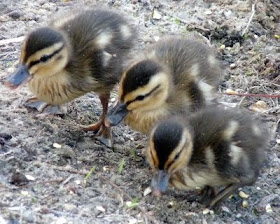
Welcome to part three of our continuing stooo-ry*:
Quacks in the Backyard:
Drama Amongst the Ducks
Drama Amongst the Ducks
Today's episode begins when I head out into the backyard to pull a few weeds, snip some blanket flowers to bring inside, and perform other menial tasks. As usual, when I open the screen door, ducks assault me from all sides, begging for corn. I throw them a cupful so I can get on with my work.
When I turn back around a few minutes later, I find that the mallard ducklings have added a new trick to their repertoire - they're now able to climb up the bank from the drought-depleted lake and make it into my backyard to enjoy the treat with the grown-ups!
 As I watch them feed, I hear that familiar sharp cry from above - the hawk is back yet again. But now I learn why these three are still around after their brothers and sisters are gone - they got mad survival skillz!
As I watch them feed, I hear that familiar sharp cry from above - the hawk is back yet again. But now I learn why these three are still around after their brothers and sisters are gone - they got mad survival skillz!All the ducks immediately fly down to the lake. The little ones don't have much in the way of wings yet, but they move just as fast as their elders, skittering as fast as they can go. Once in the water, the three ducklings immediately duck under the surface as the hawk swoops in for the kill. Half a second later, the hawk flies off, pursued by adult ducks and several mockingbirds (presumably also protecting a nest nearby) and it doesn't seem to have anything in its talons. Still, I can't be sure.
I watch the surface of the water. Up pops one baby duck, followed by a second. I hold my breath... and the third duckling surfaces. I'm sure their little duck hearts are beating like crazy, but they had survived another attack. They live to swim another day.

I can't be sure these guys will continue to outsmart the hawk. But I'm getting awfully close to deciding to give them names and a special place in my heart. I hope they survive to beg me for corn and eventually bring their own babies to My Florida Backyard, where they will always be welcome.
Check out part 1 and part 2.
UPDATE, April 29, 6:20 p.m. - A red-tailed hawk just captured one more of these little guys, again right in front of my eyes. Honestly, folks, this is starting to break my heart.
*You have to say that in your best Muppet Show "Veterinarian's Hospital" voice.



























